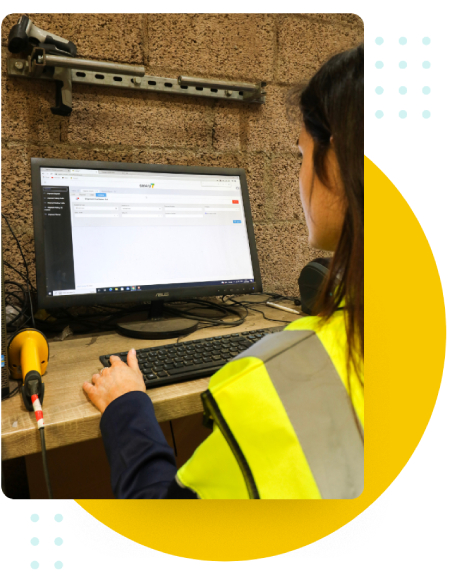Meet Canary7
The Complete Guide To Order Management Systems
Reliable, Robust 3PL Solutions; Now at your service.
Reliable, Robust 3PL Solutions; Now at your service.
Reliable, Robust 3PL Solutions; Now at your service.
The order journey of your product begins as soon as the customer confirms their purchase. From that point onwards right until the order shipment is dropped at the customer’s doorstep, you have to make sure that everything goes smoothly. After all, the way you show up as a business in terms of order management directly reflects in the level of customer satisfaction you are able to generate.
However, order management is not as straightforward as it sounds. All businesses have the responsibility to implement efficiency and consistency throughout the fulfilment journey of every single order. If you are a small business dealing with a low volume of orders, this may sound like a reasonable expectation. But as you witness your business grow and your operations expand, it will be clear that order management is not as easy to take care of as it seems.
Similarly, if you are a large establishment and have to deal with thousands of new orders every single day, you will appreciate that order management, in actuality, is quite a complex procedure that requires due dedication and commitment to effort from your side.
Either way, if you fail to establish a proper, well-refined process for order management, your business is likely to suffer. But the main problem is, how do you do that?
Many businesses, when taking the challenge of fixing their order management tactics, find it hard to not only understand what order management is, but also where to begin. Luckily, however, they can always rely on order management systems.
Order management systems help businesses streamline order fulfilment from start to finish: whether it is pick and packing services, inventory management, or the shipment processes, order management systems help you amalgamate and streamline a number of factors and procedures across the supply chain, and ensure that the way you manage each order translates into stellar customer satisfaction, and actually makes a positive contribution towards the success of your business.
Not sure what we mean? Well, worry not! This order management guide covers everything you need to know about order management, with a special focus of what order management systems are and how your business can benefit from investing in one.
Let’s dive right in!
Contents
Before we can look at what order management systems are, it is important to make sure that we understand what order management is to begin with. Believe it or not, many businesses struggle with understanding the concept of order management – not only are they not sure about why it is such a big deal, but they also can’t seem to decide exactly which processes are meant to be considered order management.
This is why it’s important to discuss the following things:

First things first: what is order management?
In the simplest of terms, work order management is a process that you have in place to ensure that every order that leaves your warehouse safely reaches the customer – with as little problems as you can manage. As such, order management involves order tracking, stock handling, managing customer data, and even post-delivery customer service relations.
For you, order management should mainly mean that you need to keep track of your inventory at all times. This will help you align your orders with inventory, and make sure that your customers get exactly what they ordered. Needless to mention, this will also involve making sure that your representatives handle the products properly and also that the pick, pack, and shipment processes you have in place are efficient and don’t cause unnecessary hindrance to your operations.
Order management systems help you automate and streamline this process – but more of that later. To be fair, order management is simply not possible in the 21st century without the help of the right order management systems. Automation is important for the efficiency that leads to effective and adequate order management, and it can only be achieved with the help of an order management system. But we will be discussing this a lot more in depth later in this guide, so make sure to keep reading.
Order processing is directly linked to order management, which is why it becomes important for us to discuss aspects as well. Essentially, order processing is the term used to refer to the entire workflow from order placement to delivery of the products. While order management is a more general term and refers to the overall way of handling orders, order processing specifically refers to the workflow that goes into refining the whole order management experience for the customer. So, consider order processing to be a central tenet of a good order management procedure.
Order processing is important because more or less, it is the ultimate link between your customer and your business. As such, if you make improvements to your order processing stage, you can eventually make improvements to the overall customer experience you are providing. Needless to say, this is important if you plan on impressing your customers and stay ahead of the competition, and therefore order processing is also very important.


If you are not already aware of the importance of order management, you are probably wondering what does an order management system do and why one should care about order management, especially good order management to begin with.
Well, for the most part, it’s simply because work order management is crucial if you are planning to ensure that you are retaining your customers. Order management streamlines all the little bits and bobs of your supply chain in regards to order processing, which in turn makes it a much smoother procedure. No discrepancies means that your delivery times are faster, and the quality of the product that reaches your customer is not compromised. End result? A very happy customer who won’t hesitate before bringing your business to you over and over again.
When you are managing your orders properly, you can avoid problems like overstocking, dead stock, and understocking. These situations can lead to financial losses and cause mismanagement within your inventory and warehouse, which is why they must be avoided. With the help of order management and order management systems, you can make sure that this never happens.
Not only that, but order management also helps you cut down on shipping errors. Again, it is important to avoid shipping errors whenever you can because not only are these heavy on your pockets, but they are also notorious for slowing down business processes and causing inefficiencies that translate into the way you deal with your customers.
So, when it comes down to it, order management is important to help you save time and money. You don’t want to waste these assets unnecessarily, because at the end of the day, the amount of money and time you end up saving is a reflection of just how well your business is doing. In that sense, it can even be said that order management is one of the key aspects that ensures that your business is on the right track to success.
There are different types of order management, and each is meant to align with the needs of a different business. We will discuss these now, so that you can understand what these types are which one aligns better with your business.

Distributed order management is a fulfilment method that helps you focus on delivery time and optimise it in a way that helps you boost productivity, but also keeps your costs low, and ensures that the management of your orders doesn’t suffer in any way.
The way distributed order management works is by combining orders taken on from multiple channels into one place. So, if you are a multi-channel business and sell your products on your website but also on other shopping platforms such as Amazon and eBay, then distributed order management is the ultimate form of eCommerce order management you should be interested in, as it helps you make sure that instead of separate records, all these orders are received by you in one place.
The perfect multi channel order management system eCommerce setups can benefit from, therefore, would be a tool of implementing distributed order management.
We know what you’re thinking: why does work order management for small businesses need to be any different from order management for other businesses. The answer to that is that although the nature of business operations are not that different even when you are a small business, you have a lot less resources to streamline them.
Therefore, order management for small businesses means smoothing out order processing without having to spend lots of money. We will get into ways to do this when we discuss the importance of inventory management systems, but as a rule of thumb, a small business should always find simple, straightforward software that doesn’t cost a lot, but also equips their supply chain with automation and technology that significantly straightens things out.
Supplier order management is a lot different than order management for a retailer – this is because essentially, you are looking at order management from a different angle. When dealing with a supplier, you are the customer, but unlike in retail transactions, it is you who should be making sure that you have everything sorted out.
Of course, there are certain limitations involved. At the end of the day, the process will be impacted by your suppliers in one way or the other. However, you should keep in mind that the more actively you take charge, the more likely it is that you won’t face any problems with supplier order management.
The two main components of supplier order management are regular communication and second comes in the shape of robust order management systems that can make the rest of the process easier.
It is not important for you to be completely familiar with all of these types of order management system. After all, you really don’t have to implement all of these in your business in order to have an efficient order management strategy in place. However, a good understanding of these will put you in a better place to establish which one of these is perfect for your business as a whole. This is why we recommend you to bookmark this page and come back to it whenever it is the most convenient for you.

The order management process will look different from business to business – however, the best way to go about order management is usually considered to be a characteristic of the overall order management process.
These are:
The order management journey of your product begins when an order is placed. Where and how an order is placed depends on your business. So, if you are a multi-channel business, the order may be placed on different channels in different ways. It can be done over the phone, through an online store, in person, or anywhere else.
Once the order is placed, the next step comprises the conveyance of the details of that order, as it is, to your fulfilment team. In the age of technology, automation, and order management systems, there is unlikely to be any delay between the placement of the order and its reception by the fulfilment team. However, for various reasons, there may be some time gap.
After your fulfilment team gains access to all the order details, they will then have to move onto locating the products that the order asks for. If this process is manual, then the fulfilment team may have to spend more time locating the products, depending on how large your inventory is. However, if this process is automated, then it will hardly take any time: an inventory management system or order management systems will help you locate just the items you need without much hassle or wasting any time.
Now, you can get to the packing of your products. Needless to say, you need to make wise packaging choices for this step, because it is here that you will be making sure that not only are you sending a product that is of top-notch, uncompromised quality, but also that it remains in that condition even in transit and that your customer receive it in pristine condition.
Once the products are properly packaged, they are ready to be shipped to the customer’s doorstep. It is important that you make sure that your packages are tracked and that the customer has access to this tracking, as well as the relevant members of your team. This is because in case things go wrong, you can take prompt action. As for the customer, they should have tracking details so that they can have a reasonable idea of when they will be receiving their products.
The sixth step starts when the order is delivered. You might be pushed into thinking that this is where the order management process ends, but good businesses also include post-delivery customer service, such as ensuring that your customers liked the order and checking in on the reviews they give you.
So, your entire order management experience can be summed up in these six steps. You will notice that in each of these steps, we advised you to shift to automation so that you can implement these in your procedure a lot more easily. This is because in order to ensure that your operations are upto the standards of the modern industry, you have to equip your warehouse, inventory, and essentially the entire supply chain, with automation.
This is where order management systems come in.
Enter your details to book a demo of the Canary7 WMS, built for 3PLs, and fulfilment houses.
Order management systems, at the very basic level, are work order management software solutions that help businesses streamline your order management experience from start to finish. It is used to track orders, keep a record of sales, maintain inventory, and make order fulfilment simpler, speedier, and more memorable for the clients.
Order management systems are not just concerned with processes, they also take into account the role of people and help you, as a business, equip your staff with the resources they need to evolve your order processing methods. In doing so, your website order management system is meant to guarantee that your products will find their way to your customers without having to deal with any hurdles or hassle.
There are many aspects of your order management experience that are touched by an website order management system. These include, but are not limited to, customers, sales channels, product information, inventory levels, and location. The best order management software will also help you factor in suppliers for purchasing and receiving your products, post-delivery services which may often include refunds or returns, and other aspects such as picking, packing, and shipping. In a way, order management systems are the ultimate key to tying all of these together.
But how does it achieve all of that?
Thanks to special features that are meant to deal with all your order processing needs, robust order management systems are built to tackle even the most challenging aspects of order management. These features and functions include:
With the inevitable and the inarguable rise of omnichannel business models, your business is likely to either be one or be in the process of becoming one. For any business wishing to scale up, going multi-channel or omnichannel is the best way. In fact, the reason that running a business is slightly more feasible in today’s time and age is that it is easy for you to reach your customers through a variety of channels – what else could you possibly need?

As we have already discussed above, order management is simply not possible without automation. Automation is the one aspect that helps you create an interconnected ecosystem out of all the little processes involved in order fulfilment as a whole. As a business owner and a merchant, if you automate your internal processes, you will be making sure that your business doesn’t face any major issues from the moment you receive the order right until the fulfilment process has been completed and your order reaches the customer’s doorstep.
In addition to that, it automates a lot of processes that would, prior to automation, be dependent on manual labour. This is not desirable as it makes the job harder for your staff. Once these processes are automated, your workers don’t have to worry about the mundane work processes and their efforts can be invested elsewhere. All in all, automation is important, and it is only with the help of order management systems that businesses can implement it in their operations covering order processing.
Not all businesses realise this, but reverse logistics are just as important picking, packing, and shipping – if not more. For most people, shopping in the 21st century is such a satisfying experience because they know that if they don’t like the product they receive, they can always return it; without hassle. As a business, it is your job to ensure that you are able to meet this standard set by them, or else, you are more than likely to lose a customer.
However, reverse logistics is not as easy as one would expect it to be, and can actually complicate the things across your supply chain – but only if you fail to create the proper framework for it to operate within. And in case that happens, you will be losing not only money but also customers, which is certainly not something any business wants.

This inadvertently means that you will be including a mechanism in your order management process that ensures that your customers are happy and satisfied with the products you are sending their way, which in turn boosts future sales.

When it comes to order processing, your customer and their satisfaction should be your number one focus. For these reasons, order management systems can also be considered as tools to improve your customer relations and customer order management in general, especially considering the fact that they help you keep track of all the important customer information you need. So, good order management systems can help you gauge the customer’s order history, lifetime value, geographical location, and other demographics.
Also with the help of order management systems, you can actually tap into new demographics and a larger target audience, simply because it is easier for you to keep up with it. Since order management systems don’t operate in connection to just one space, there are no geographical bounds that you have to keep in mind. If you are in Europe, you can easily manage shipment across Asia, because a product order management system will help you understand your business activity in that area better!
Again, this is great for your marketing as well. Because you will have data on customers from each segment of your target audience, you can create different campaigns that appeal to these different segments, and hence make marketing a bigger success for your business. Order management systems and the way they handle customer data also means that it is possible for you to customise and more importantly, personalise your marketing efforts in a way that appeals to your entire audience.
For many businesses, having all of their data in one place is very important. When you have all of it in one central location instead of all over the place, you can benefit from it in a much better way. For example, it is crucial for you to understand your spending in terms of how much you are earning, since this way you can align your budget with your profits or losses.
Order management systems help you by integrating order processing and other important processes within the order management procedure with your finance software. So, you can extract important data on sales, inventory, and order processing, and feed it to your finance and accounting software so that it can factor these aspects in when calculating your revenue and shaping your financial decisions. In short, you can achieve the best of both worlds with the help of a product order management system.

What’s even better is that you don’t require manual data entry when it comes to an order management system. As any business owner will appreciate, adding finances manually can be a tiresome, boring job – but even more importantly, it doesn’t offer you any flexibility to make mistakes. So, relying on automation can make it easier for you to make sure that everything remains efficient and up to the mar

We have discussed the important features of a good OMS system – but the truth is, not every order management system will have these. When picking an order management system for your company, you should not only look for a system that offers the above-mentioned features, but also for OMS software that doesn’t have the following problems:
The best order management software will offer you powerful integrations across multiple channels. If an order management system doesn’t do that for you, it’s not a good choice. If your order management software system doesn’t allow you to tap into CRM, PIM, ERP, and eCommerce platforms such as Amazon and Magento, it is not the best fit for you.
No matter what industry your business is a part of, speed is a crucial factor for any business dealing with customers. If your order management system doesn’t promise lightning-fast syncs, it is not worth investing in (considering that the whole point of order management is to bring efficiency to your work processes, not to take away from them!)
Order management is a complex procedure, which is why the order management solutions you employ are also likely to be at least somewhat complex and complicated. Therefore, any order management system you invest in should come with proper documentation that can be relied on in terms of learning how to navigate the software system.
If you are looking to grow as a business, you also need an order management system that will grow with you. This can only happen if the order management system software is regularly updated – if it’s not, then you are investing in a system that will go obsolete soon and you will more or less be wasting your money.
Barcodes and RFID technology are an important part of inventory management and order management and therefore, any software solution that you pick should be friendly towards these aspects. This technology is specifically important if you are planning to overtake your competitors, so you shouldn’t settle for a software system that doesn’t help you achieve it.
OMS systems are made to help you achieve the following benefits:

Today’s business environment means that you can afford no mistakes. For this reason, order accuracy is important. If you are not looking into order management systems and processing your orders manually, then you are setting yourself up for disaster! This is because manual order processing involves more chances of human error, and hence slows down things to a great extent.
With the help of an order management system, you can achieve order accuracy and evolve the customer experience with insightful, precise details. Especially for eCommerce businesses, OMS software can really help you ensure that you get the information on each and every order right. This also means that OMS eCommerce is the only way you can actively avoid logistical problems and save yourself from losing money on mistakes that could have easily been worked around.
If there’s one thing that every shopper expects from a retailer, its speed. Your delivery times have to be fast if you want your customer to come back to you for business – next day if possible! The longer it takes for you to process your orders, the longer it will take for them to arrive, and the worse impression they will have on your customer.
However, thanks to order management systems, you don’t have to worry about any of that. An OMS platform streamlines every single process involved in the fulfilment of an order; from pick and pack to shipping, everything is not only automated, but also tracked so that no hindrances can slow down these processes. Your warehouse order picker will thank you for equipping the warehouse with an order management system, that’s how much of a help it can be. It can improve the general efficiency of warehouse order picking methods, and can also enable multi order picking and packing without a lot of hassle.
With the help of an OMS platform, you can identify the fulfilment centre that is the closest to the delivery location, and then engage that centre to meet the order requirements. Needless to say, this cuts down on the delivery time and you are able to send your products out on time.
When everything goes well on the order processing side of things, you are automatically setting yourself up for increased customer satisfaction. You need to remember that your customers are used to a smooth and efficient order fulfilment process. All businesses they interact with on a daily basis are constantly striving to make the delivery as smooth for them as possible. Essentially, what this means is that they have a certain standard set when it comes to receiving their orders, and if you want to ensure your success, you must make sure that you are meeting this standard.
Order management systems help you achieve the best sort of customer order management. A good order management system will enable you to give your customers order insights that they like having – for example, tracking information. Customers can track their products from the start of the fulfilment journey right till the end of it, which conveys to them that they are fully in control of the process. This, in turn, raises your brand value in their eyes and increases chances of repeat business.
Stockouts are one of the biggest challenges you can face as a retailer, and the lack of good forecasting mechanisms can very be blamed for that. If you don’t forecast your customer demand properly, you are depriving your inventory management processes of the core aspect that aligns it with increased profitability of your products.
Unfortunately, lack of forecasting can very well lead to over-stocking and stockouts. In either of these situations, you are increasing the cost of your business and putting yourself at the risk of losing sales, which is obviously something you should avoid.
Thankfully, work order management software can help you tackle both of these. With the help of an order management system, retailers can get an insight into both their high-selling and low-selling seasons. This means that you can align your inventory with these sales cycles and make sure that popular products are always in stock. It also means that you can tap into consumer trends and make sure that you are not ordering more than what is needed or something that the customer isn’t wholly interested in. All in all, with the help of an order management system, you can greatly improve your inventory management processes as well.
No matter how small your business is, the ultimate dream for every business owner is to expand; internationally if possible. And who can blame them? With globalisation at its peak and the global market at its most lucrative, it is understandable that businesses want to tap into a global market.
However, with OMS systems, shipping your products internationally could quickly turn into a nightmare. Afterall, streamlining fulfilment for an international order is no easy task, and there are quite a lot of things that you need to factor in before you commit to this process.
But with the help of order management, you don’t have to worry a lot. A good order management system will not only help you scale up by tackling international orders, but also equip you the digital tools needed to do this. For example, an order management system can easily help you send details forward to 3PL partners you have in any country your customers are in!
Let’s say you have a “Manhattan order management system” because you and your business are based in Manhattan. However, having a Manhattan order management system doesn’t mean that you are restricted to keeping your operations in Manhattan and the US is general! You can very easily expand your business and manage orders from London, Paris, Berlin – just as well as you do for Manhattan.
Again; these benefits of an order management system are simply the tip of the iceberg. There are many other reasons as well that make an order management system an integral component of any business, especially in terms of its development.
And now, to understand more about how order management systems work, let’s have a look at three typical types of order management systems that you can get your hands on.

These order management systems are a part of a greater integrated software suite built especially for retailers. They have integrated features that can be implemented across the supply chain and streamline the fulfilment process to a great extent.
Such an order management system consists of multiple software solutions, including warehouse management software, inventory management software, labour management software, warehouse control software, and of course, order management software. Regardless of the nature of your business, you can benefit from the integrated suite of solutions provided in a supply chain order management system.
Through this ecosystem of connected software will help you make sure that not only all the important aspects of fulfilment are interconnected, but also that your business is growing holistically instead of individually. These order management systems may be on the slightly more costly side, but it is an investment that actually leads to more profitability for your business – especially if you are looking for multichannel order management.
Similar to the retail software suite mentioned above, these order management systems also are a part of a bigger software solution. However, instead of being a standalone system per se, this software solution is an additional module of an ECP, ERP, and POS.
Needless to say, this doesn’t usually provide a very targeted approach towards order management, since it is more or less just a secondary component of the system. However, they are not always a bad option, especially if you are a small business that is not struggling with a very large volume of orders, then you can benefit from these order management “systems.” But remember, in order to set a good base for your business to grow on, it is always better to invest in proper order management software from the very start.


If you are a large corporation, you might want an on-site order management software. This is made possible with enterprise order management solutions. These are dedicated software solutions that are set on-premise, and hence take care of all the processes within your workplace.
Just like every other kind of on-premise software, there are some major drawbacks to enterprise order management solutions as well. These tools are usually unnecessarily complicated, and require a whole team of specialists to set up. Not only that, it may also cost you more money than necessary without even solving your problems. Therefore, even if you plan on opting for the enterprise order management solutions, you must do thorough research and make sure that you are not making the wrong choice.
Remember; the list above is not exhaustive by any means, and chances are that there are many other types of order management systems that your business can benefit from. The key here, therefore, is to research!
When it comes to picking the best order management software, you must research properly and make sure you pick a software solution that aligns with your business needs. A little research can go a long way and can help you save a ton of money! So, whether you are interested in general work order management or order management such as Shopify order management and Magento order management, you can benefit from order management as a whole.
When it comes to picking the best order management software, you must research properly and make sure you pick a software solution that aligns with your business needs. A little research can go a long way and can help you save a ton of money! So, whether you are interested in general work order management or order management such as Shopify order management and Magento order management, you can benefit from order management as a whole.
Here are a few things you should ask yourself before you actually take the plunge and commit to an order management system:
There is absolutely no need to splurge on an order management system when you can’t make it a forever element of your strategy. So, you can spend $1000 on getting an order management system once, but will you be able to keep up with the costs required for it to continue being a part of your business. In short, it is important to ensure that the order management system you pick for your business is not too heavy on your budget, especially in the longer run.
Ideally, you should not be committing to an order management system that is not flexible. The whole point of getting one is for it to be a high-functioning part of your business, and that can only be a possibility if it can be adjusted in accordance with you needs as a business. Therefore, it is absolutely important to ensure that it is a flexible solution that keeps you in charge of all your business activity, and doesn’t require you to settle for anything less than you require from it in the area of order management.
In today’s time and age, accessibility is a huge factor especially when it comes to business development. Essentially, you need an order management system that can be accessed from anywhere in the world, so that you can constantly be in touch with your order activity and can make sure that there are no gaps or lags that can potentially hinder the growth of your business. You would also benefit from getting a solution that is accessible not only for you, but also for the rest of your team so that you can all work collaboratively and improve your performance as a team.
In order for you to make sure that an order management system can be a long-term partner of success for you, you need to ensure that it is scalable. So, you should want to invest in an order management solution that grows with you! Most software systems will actually restrict your growth, but if you want to make sure that you are achieving success in terms of business development, you will 100% stay away from these solutions and instead choose something that uplifts your expansion as a whole.
Order management systems are crucial when it comes to ensuring the success of your business. However, not all order management software solutions are created equal and in order to ensure that you pick the one that actually contributes towards the success of your business, you must make sure that you are choosing the right order management system. This guide will help you make a choice that actually leads to increased profitability for your business, and can genuinely turn out to be a long-term solution for you!
Also, since Canary7 checks all the order management system boxes mentioned in this guide, why don’t you sign up for a demo and see how we can help you with our order management services? It’s completely free of cost, and will help you test the waters before you actually commit to a software solution.
Enter your details to book a demo of the Canary7 WMS, built for 3PLs, fulfillment houses, and online retailers.
You can see how this popup was set up in our step-by-step guide: https://wppopupmaker.com/guides/auto-opening-announcement-popups/
You can see how this popup was set up in our step-by-step guide: https://wppopupmaker.com/guides/auto-opening-announcement-popups/